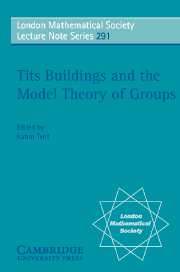Book contents
- Frontmatter
- Contents
- Preface
- List of speakers and talks
- Basics on buildings
- An introduction to generalized polygons
- Buildings and classical groups
- Twin buildings
- Twin trees and twin buildings
- Simple groups of finite Morley rank of even type
- BN-pairs and groups of finite Morley rank
- CM-trivial stable groups
- Amalgames de Hrushovski: Une tentative de classification
- Rank and homogeneous structures
- Constructions of semilinear towers of Steiner systems
- Introduction to the Lascar Group
Twin trees and twin buildings
Published online by Cambridge University Press: 12 January 2010
- Frontmatter
- Contents
- Preface
- List of speakers and talks
- Basics on buildings
- An introduction to generalized polygons
- Buildings and classical groups
- Twin buildings
- Twin trees and twin buildings
- Simple groups of finite Morley rank of even type
- BN-pairs and groups of finite Morley rank
- CM-trivial stable groups
- Amalgames de Hrushovski: Une tentative de classification
- Rank and homogeneous structures
- Constructions of semilinear towers of Steiner systems
- Introduction to the Lascar Group
Summary
Introduction
A twin tree comprises two trees, both without end points, and an integervalued “codistance” between vertices in one tree and vertices in the other. This codistance, defined in section 2, satisfies some straightforward properties reminiscent of the distance between vertices in a single tree, and it compels the two trees to be isomorphic to one another.
Single trees have been used extensively in mathematics, mainly in connection with groups that act on them. For example the group GLn over a field having a discrete valuation (a field such as the p-adic numbers) acts very naturally on a Bruhat-Tits building, and when n = 2 this building is a tree — see for details on the action of GL2 on trees. The theory of buildings has been extended by J. Tits and the author (see) to include twin buildings, which arise from Kac-Moody groups. A twin building of rank two is a twin tree, so Kac-Moody groups of rank two act on twin trees.
The theory of twin trees has been developed jointly by Tits and the author (see and, and part of the purpose of this paper is to adumbrate the principal results published so far, and to indicate the direction of current research. I shall also explain the connection with twin buildings and describe how twin trees can be used to obtain interesting groups acting on certain hyperbolic buildings.
- Type
- Chapter
- Information
- Tits Buildings and the Model Theory of Groups , pp. 119 - 138Publisher: Cambridge University PressPrint publication year: 2002



